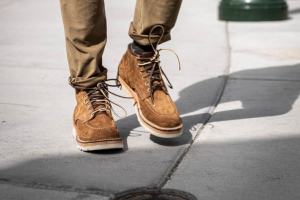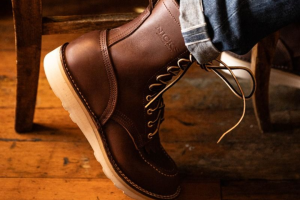What Is A Good Price For Leather Boots?
What Is A Good Price For Leather Boots? It Isn't As Simple As You Think…
We get it. You don't want to pay more than you feel you should for something, from leather boots to cars to...literally anything. It's not hard to understand that.
But when people ask that question, like if they're searching for it in Google or asking someone on Facebook or in some forum somewhere, they might not really understand what they're asking.
Usually, someone wants to know what the bare minimum they should spend is. But are you really saving money by spending the bare minimum? Well...that's a bit more complicated.
It isn't always the case with any consumer goods that you have to pay top dollar or else you'll be miserable...but it's usually the case that investing in quality can get you better results in the long run.
So let's talk about what "a good price for leather boots" actually is.
Not All Leather Boots Are Created Equal
The fact is not all leather boots are created equal, whether we're talking about leather work boots or heritage boots.
Quality in bootmaking comes down to materials and construction. A boot is either made with the best materials or it isn't, and a boot is either made to the strictest standards or it isn't.
Where more budget-friendly brands save money is by using less costly materials that are good enough to work most of the time.
They use construction techniques and QC practices that consistently turn out products that're good enough to work most of the time.
They use sizing that's good enough to fit most people most of the time.
The question is will their product be "good enough" for you...and it's easier than you'd think to not be, especially when used hard.
A lot of mass-manufactured boots have less-than perfect stitching, which can easily come undone if you're working hard every day. Soles that are only glued to the footbed can come unglued.
And a lot of boot companies' proprietary sizing conventions may mean the numerical size that normally fits your feet gets you into a pair of boots that's too large or too small. Less-than optimal fitment can lead to discomfort or even foot or lower leg injury over time.
Can a boot that's offered at a lesser price point give you the comfort, durability and service life you need? Yes, they can...but there's a greater risk that they won't.
Leather Boots And False Economies
"False economy" is where you spend less on something because you think it saves you money, but you end up having to spend money elsewhere and undo the savings.
Think of it like this: some people like hybrid cars because they use less gas.
However, you have to pay more to get a hybrid car than a regular one. The extra cost of the hybrid drivetrain (plus loan interest and taxes!) can end up being more than the buyer ever saves on gas during the time that they own it...and usually is, when you crunch the numbers.
That's a false economy, and believe it or not, you can easily get into a false economy by spending less on leather boots.
A lot of factory boots don't have great arch support, which means you also have to buy inserts. A lousy set will run you $15 at Walmart, but a really good pair of inserts (say, Spencos) can run you $50 for the arch support models.
If you need to add inserts for whatever reason, that's an additional cost.
Another area where less expensive leather boots will save money is in construction.
Cork footbeds will mold to your feet, but eventually start to break apart after years of repeated compression. Fiberboard footbeds flatten out to nothing in a matter of months with casual wear; possibly weeks with heavy use.
Glued-on soles can come unglued, if the soles are only glued to the footbed.
Cheaper outsoles - and mind you, Vibram soles aren't terribly expensive but alternatives can save a business thousands or millions per year - can wear faster, needing replacement in a shorter period.
And what's the point here?
By saving money with a "better price" or more accurately, a price that you think is better for you, you may have to pay for repairs or replacement a lot sooner.
Put it like this.
Let's say you can get a pair of boots for $200, but you have to have them resoled every year for another $150, and replaced every two years because your job just eats footwear. They cost $200 to buy, but actually cost you $350 per pair per two years' of use.
Or...let's say you bought a pair of boots that cost $500, which only need to be resoled every other year for $150. Let's also say that instead of replacement, they only need a rebuild after six years for $250, which includes a resole.
In ten years' time, the first brand/model of boots will cost you $1750 in resoles and replacements. The second only costs you $1250, despite being more than twice as expensive to start with...or so it would seem.
It isn't always true, but sometimes a higher buy-in yields lower running costs longer term. Are cheaper boots really less costly? You'd think so...but they might not be.
What Is A Good Price For Leather Boots? It Really, Really Depends
So when someone asks "what's a good price for leather boots"...it's almost impossible to put a real number on it.
A Good price how? Good price in terms of what you're paying for in materials and build? Or relative to some other product at some other price point?
What one person needs from a pair of boots is different from what another person needs. What one person wants is different from what another person wants.
You need to consider what you need and what you want. If you're on your feet all day, every day, doing a demanding job, investing in the best boots you can get for your own safety and comfort will pay dividends.
If you're getting a pair of boots for casual use...it depends on what you want in a boot and what you're willing to spend to get it.
Some people want a pair of heritage boots to wear to the office and around town. They want a pair of boots or shoes that are sturdy, attractive, and durable.
Some people want an all-purpose pair of boots for outdoors. Working in the yard, hiking, hunting and so on...but they aren't wearing them every day.
Some people need work boots, but light manufacturing, warehouse work, and residential construction put less wear and tear on a boot than logging will.
And then some people need firefighter boots. Wildland firefighting is one of the toughest jobs in existence; you cannot demand more from a pair of boots than that job does. Usually, they demand the best because anything less can get them killed.




